
 In 1945 the Americans bombed the real bridge on the river Kwai. The centre parts of the bridge (the flat bits) are new, and the original part of the bridge has the curved sides.
In 1945 the Americans bombed the real bridge on the river Kwai. The centre parts of the bridge (the flat bits) are new, and the original part of the bridge has the curved sides.
We could walk on the bridge; it is a rail bridge only, and not available for road transport.
 There was a wooden bridge built about one hundred meters up river from this bridge, and that bridge was used while the prisoners built the metal bridge, which was #277 of over 600 bridges built to accommodate the railway. Later the wooden bridge was used again after the bombing of this bridge.
There was a wooden bridge built about one hundred meters up river from this bridge, and that bridge was used while the prisoners built the metal bridge, which was #277 of over 600 bridges built to accommodate the railway. Later the wooden bridge was used again after the bombing of this bridge.
Before we caught the train to Numtok, which is now the end of the line, we visited the Kanchanaburi War Cemetery – a very emotional place as you walk passed thousands of plaques, which list the name, rank, regiment, age and date of death.


Lest we forget the 6,982 Australian, British and Dutch prisoners.
 There is another cemetery a couple of kilometers away with a further 1693 prisoners.
There is another cemetery a couple of kilometers away with a further 1693 prisoners.
One hundred and thirty three Americans also died on the railways, but their bodies were repatriated back to the US.
It is estimated that half of the 180,000 Asians, (Malays, Burmese, Thais, Chinese etc) who were forced to help build the railway, also died, but they are not buried in these cemeteries.
Our destination, by train, is Numtok – the line used to go to the Burmese / Thai border, but after the war the line from Numtok to Burma was ripped up. I have heard that there is a very small possibility that the missing line might be reconstructed.
 The notice tells us that the station is the River Kwai Bridge, but it is Kanchanaburi, with a thriving market on the platform area to keep the tourists happy.
The notice tells us that the station is the River Kwai Bridge, but it is Kanchanaburi, with a thriving market on the platform area to keep the tourists happy.
 Our train has arrive.
Our train has arrive.
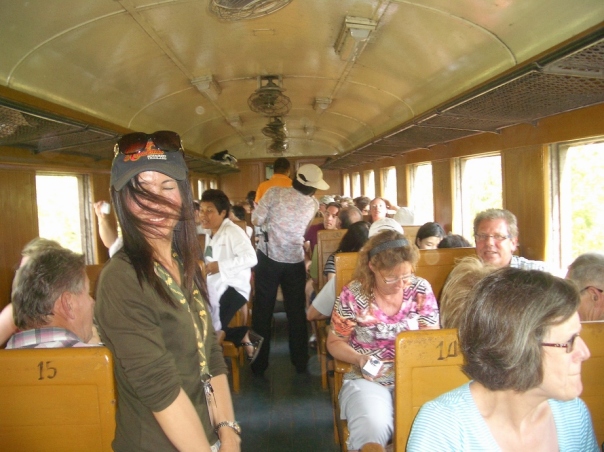
Open windows, open doors and ineffective fans trying to keep us all cool. On looking down I was able see the sleepers and track through cracks in the floor. Not something I was used to on European or Australian trains, but all part of the ‘adventure’. The line is a single line track so if you miss the train you have to wait for it to do the round trip.
The line is a single line track so if you miss the train you have to wait for it to do the round trip.
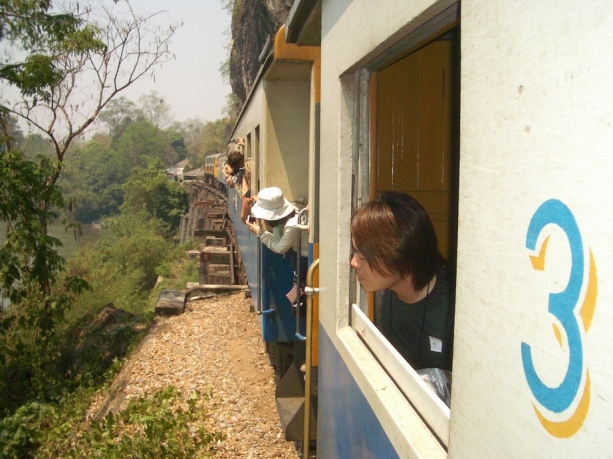 We are about to cross the viaduct, which was built by the prisoners in seventeen days.
We are about to cross the viaduct, which was built by the prisoners in seventeen days.
 Approaching the end of the line – Numtok.
Approaching the end of the line – Numtok.

 The Wang Pho viaduct – hand made . . . in 2016 it is 73 years old . .
The Wang Pho viaduct – hand made . . . in 2016 it is 73 years old . .
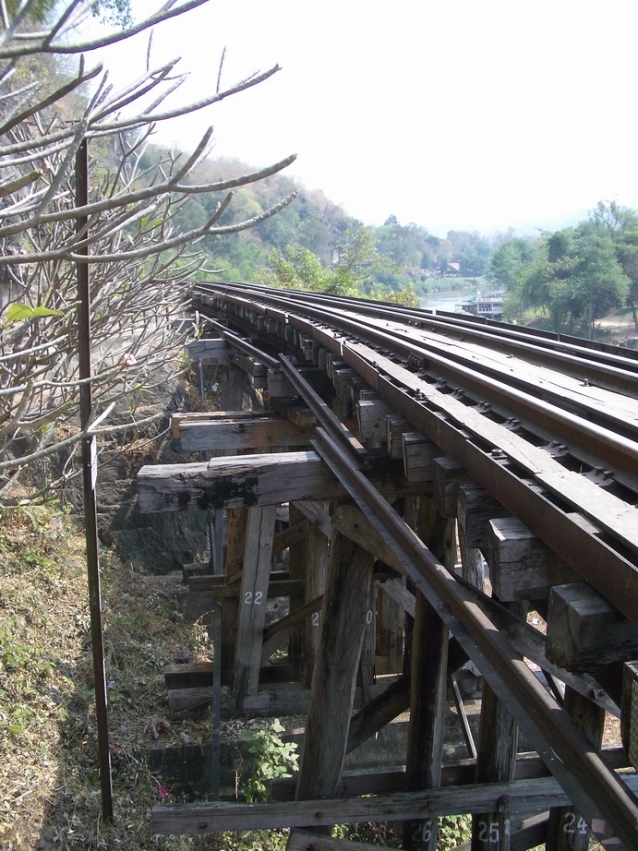
One dead prisoner for every sleeper of the 415 km railway –
They only had elephants to help, because they didn’t have any earth moving equipment.

Along side the viaduct was a large cave. This cave was used by the POWs as a ‘hospital’ it is now a Buddhist Temple in remembrance.

The correct name for the River Kwai is Khwae Noi, meaning small tributary, which merges with Khwae Yai River to create the Mae Kong River.
Pierre Boulle, a Frenchman, who had experienced great hardship after being captured by the Vichy French on the Mekong River, wrote a novel called ‘Le Pont de la rivière Kwaï’ – The Bridge of the River Kwai, which was later made in to a film, which became a great success.
 It was such a success that people flocked to Thailand in an effort to find the Bridge of the River Kwai. The river didn’t exist, but the Khwae Noi did . . . .so in 1960 the river was renamed Kwai, which helped the Thai economy considerably.
It was such a success that people flocked to Thailand in an effort to find the Bridge of the River Kwai. The river didn’t exist, but the Khwae Noi did . . . .so in 1960 the river was renamed Kwai, which helped the Thai economy considerably.
The other small detail is that the film Bridge on the River Kwai was made in Ceylon (now Sri Lanka) not Thailand.
It’s an odd world – on checking a few facts for this blog I came across Lt Col Philip Toosey, who was the real Colonel in the camp that built this part of the railway.
He was nothing like the Alec Guinness character who collaborated with the Japanese – I believe Alec Guinness was not happy portraying this type of character.
Col Toosey had his men commit as much sabotage as possible, and I heard that he even collected termites and spread them around the wooden bridges in the hope that they would start eating . . . .
At the end of the war, during the war trials in Japan, Col Toosey spoke up for Sgt Major Saito, who was second in command, (he was portrayed as a Colonel in the film), because he treated the POWs better than many of the guards. Saito respected the Colonel and later they corresponded.
Over two hundred Japanese were hanged for war crimes, and a large number of others spent many years in gaol.
Saito said that Col Toosey showed him what a human being should be, and this changed his life. On the Colonel’s death in 1975 (he was 71), Sgt Major Saito travelled from Japan to pay his respects at the Colonel’s grave side. Not until Sgt Major Saito’s death in 1990 did his family realise that he had become a Christian, because of Colonel Toosey.
After the war the Colonel returned home and worked in Liverpool, UK.
The odd bit for me is that Col Toosey came from Birkenhead, which is across the river from Liverpool. He lived in Upton Road and went to school at Birkenhead School.
I lived about a hundred yards or so from this school, and between 1956 and 1960 I used to deliver newspapers for the news agency in Upton Village. My delivery area included all of Upton Road to Bidston hill, I just wondered if I used to deliver to the Colonel’s house.

 The Pacific Jewel seem s to have a focus on family fun from ‘rock climbing’ to flying fox from fore to aft, or it could be the other way around.
The Pacific Jewel seem s to have a focus on family fun from ‘rock climbing’ to flying fox from fore to aft, or it could be the other way around. The wire is the flying fox . . . .at my age I might give it a miss.
The wire is the flying fox . . . .at my age I might give it a miss.


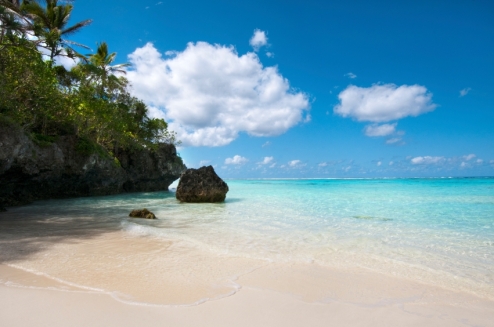


 In 1945 the Americans bombed the real bridge on the river Kwai. The centre parts of the bridge (the flat bits) are new, and the original part of the bridge has the curved sides.
In 1945 the Americans bombed the real bridge on the river Kwai. The centre parts of the bridge (the flat bits) are new, and the original part of the bridge has the curved sides. There was a wooden bridge built about one hundred meters up river from this bridge, and that bridge was used while the prisoners built the metal bridge, which was #277 of over 600 bridges built to accommodate the railway. Later the wooden bridge was used again after the bombing of this bridge.
There was a wooden bridge built about one hundred meters up river from this bridge, and that bridge was used while the prisoners built the metal bridge, which was #277 of over 600 bridges built to accommodate the railway. Later the wooden bridge was used again after the bombing of this bridge.

 There is another cemetery a couple of kilometers away with a further 1693 prisoners.
There is another cemetery a couple of kilometers away with a further 1693 prisoners. The notice tells us that the station is the River Kwai Bridge, but it is Kanchanaburi, with a thriving market on the platform area to keep the tourists happy.
The notice tells us that the station is the River Kwai Bridge, but it is Kanchanaburi, with a thriving market on the platform area to keep the tourists happy. Our train has arrive.
Our train has arrive.
 The line is a single line track so if you miss the train you have to wait for it to do the round trip.
The line is a single line track so if you miss the train you have to wait for it to do the round trip. We are about to cross the viaduct, which was built by the prisoners in seventeen days.
We are about to cross the viaduct, which was built by the prisoners in seventeen days. Approaching the end of the line – Numtok.
Approaching the end of the line – Numtok.
 The Wang Pho viaduct – hand made . . . in 2016 it is 73 years old . .
The Wang Pho viaduct – hand made . . . in 2016 it is 73 years old . .


 It was such a success that people flocked to Thailand in an effort to find the Bridge of the River Kwai. The river didn’t exist, but the Khwae Noi did . . . .so in 1960 the river was renamed Kwai, which helped the Thai economy considerably.
It was such a success that people flocked to Thailand in an effort to find the Bridge of the River Kwai. The river didn’t exist, but the Khwae Noi did . . . .so in 1960 the river was renamed Kwai, which helped the Thai economy considerably. Floating Market outside Bangkok.
Floating Market outside Bangkok.
 Hire a boat and enjoy the experience.
Hire a boat and enjoy the experience.


 The locals also buy from the boat people. The young girl had just bought a hot meal.
The locals also buy from the boat people. The young girl had just bought a hot meal.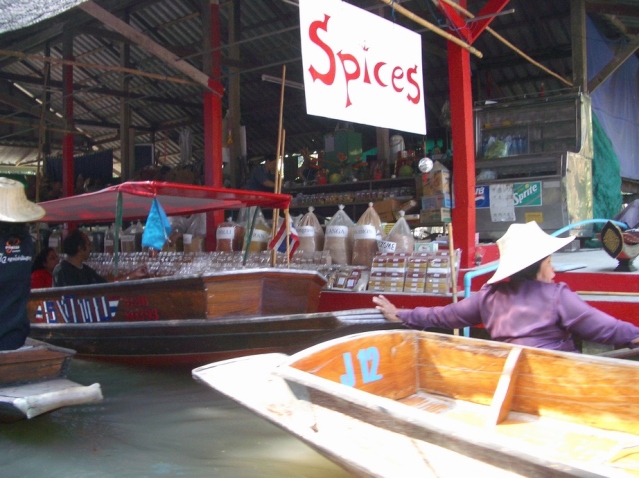









 In many ways it is just a normal market – except for the railway lines.
In many ways it is just a normal market – except for the railway lines.



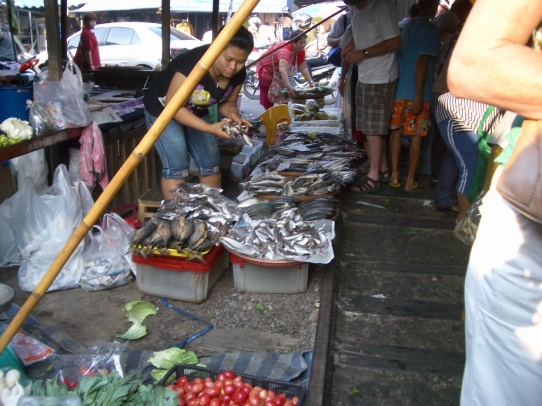
 But everything changes when they hear the train approaching – drop or pull up the awnings and shade cloth. Clear the sale goods off the line and stand back.
But everything changes when they hear the train approaching – drop or pull up the awnings and shade cloth. Clear the sale goods off the line and stand back.
 As you see the side of the train is just high enough to pass over the farm products.
As you see the side of the train is just high enough to pass over the farm products.

 We visited the Ho Chi Minh mausoleum, where we saw his embalmed body in a glass case. He died in 1969.
We visited the Ho Chi Minh mausoleum, where we saw his embalmed body in a glass case. He died in 1969.



















 Looking down the other side of the hill.
Looking down the other side of the hill. The river below, which is tidal.
The river below, which is tidal. I can see fishermen getting ready for an early morning outing.
I can see fishermen getting ready for an early morning outing. Bottom of the hill and this view always catches my eye.
Bottom of the hill and this view always catches my eye.
 Someone is making ready for a dawn kayak paddle.
Someone is making ready for a dawn kayak paddle.
 Part of the park with wood fired BBQ and picnic shelter.
Part of the park with wood fired BBQ and picnic shelter.

 Drinking in the views
Drinking in the views


 Homeward bound, the river is now on my right.
Homeward bound, the river is now on my right. Civilisation in the distance.
Civilisation in the distance.



 The driveway to the front of the hotel.
The driveway to the front of the hotel.






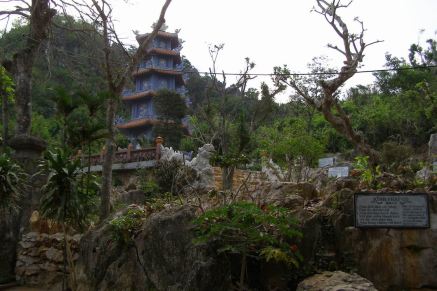 Temples at the top.
Temples at the top.
 China Beach was a favourite R & R beach for western service men during the Vietnam war (called the American war in Vietnam).
China Beach was a favourite R & R beach for western service men during the Vietnam war (called the American war in Vietnam). Pillboxes can still be seen in the centre of this photograph – a close up of the pillbox is the main picture at the start of this blog.
Pillboxes can still be seen in the centre of this photograph – a close up of the pillbox is the main picture at the start of this blog.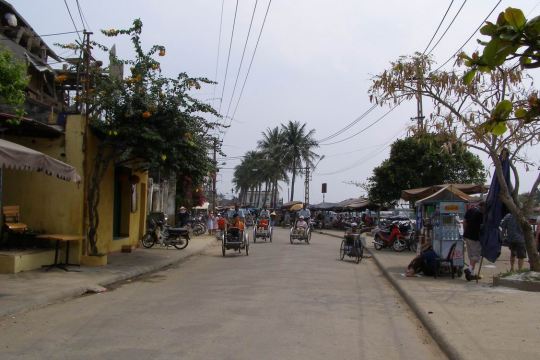 A wide street scene along Hoi An waterfront.
A wide street scene along Hoi An waterfront.


 Hoi Ann from the river – a nice quiet setting.
Hoi Ann from the river – a nice quiet setting. Market day ?
Market day ?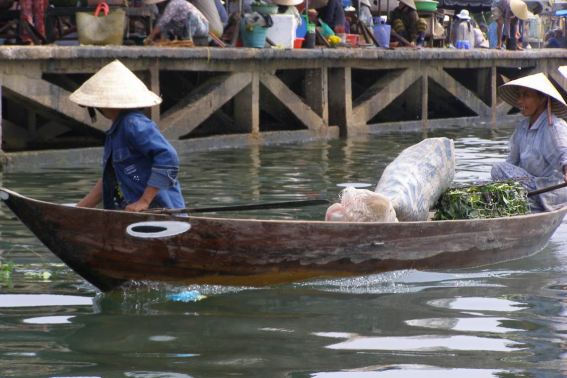


 The local fisherman didn’t miss a trick in trying to sell us fish – he bounced down our boat waving his fish.
The local fisherman didn’t miss a trick in trying to sell us fish – he bounced down our boat waving his fish.
 Red Bridge cooking school
Red Bridge cooking school
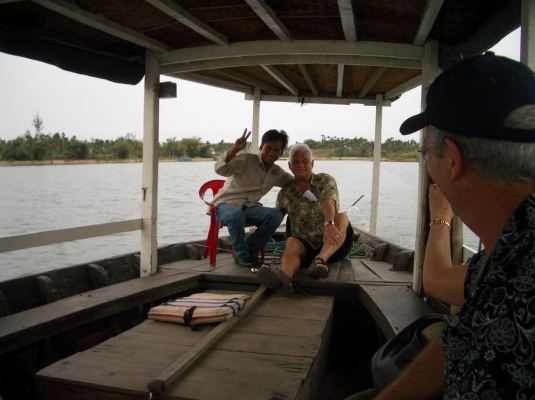 We arrived safely back at Hoi An.
We arrived safely back at Hoi An.